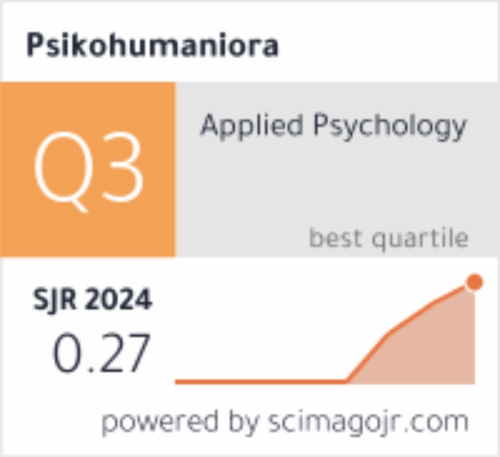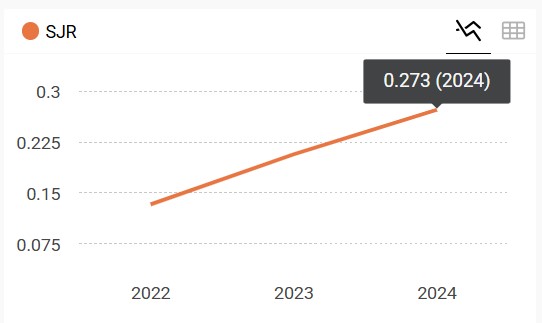Analisis Koping dan Pertumbuhan Pasca-trauma pada Masyarakat Terpapar Konflik
DOI:
https://doi.org/10.21580/pjpp.v3i2.2818Keywords:
Aceh, community, conflict, coping, post-traumatic growthAbstract
Prolonged conflict in Aceh has caused trauma in people who were directly affected. Aside from post-traumatic disorder, a traumatic event can bring out post-traumatic growth (PTG) too. PTG is a positive transformation that is resulted from an adaptation process of traumatic events in life. This study aimed to examine the relationship between coping and PTG. There were 55 respondents involved in this study, who were obtained by using purposive sampling technique. The sample criteria were those experiencing by themselves certain events during the conflict, men and women over 20 years old, able to read and write, and willing to be respondents for the study. Data were collected using a demographic questionnaire, Post-traumatic Growth Inventory (α = .88) and Ways of Coping Questionnaire (α= .89). The data were analyzed with the Pearson Product Moment Correlation. The analysis results showed a significant correlation between post-traumatic growth and coping (r = .523; p < .01). In addition, coping ways that correlated with post-traumatic growth were seeking for social support (r = .545), distancing (r = .315), self-control and accepting (r=.274), while confronting and escape did not have a correlation with post-traumatic growthDownloads
References
Ai, A. L., Tice, T. N., Whitsett, D. D., Ishisaka, T., & Chim, M. (2007). Postraumatic symptoms and growth of Kosovar war refugees: The influence of hope and cognitive coping. Journal of Positive Psychology, 2(1), 55–65. https://doi.org/10.1080/17439760601069341
Almedom, A. M. (2005). Resilience, hardiness, sense of coherence, and posttraumatic growth: All paths leading to “light at the end of the tunnel”? Journal of Loss and Trauma, 10(3), 253–265. https://doi.org/10.1080/15325020590928216
Bjorklund, B. R., & Bee, H. L. (2008). Journey of adulthood (6th ed.). London: Prentice Hall.
Calhoun, L. G., & Tedeschi, R. G. (2004). Post traumatic growth conceptual foundations.pdf. Psychological Inquiry.
Connor-Smith, J. K., & Flachsbart, C. (2007). Relations between personality and coping: A meta-analysis. Journal of Personality and Social Psychology, 93(6), 1080–1107. https://doi.org/10.1037/0022-3514.93.6.1080
Davis, C. G., Wohl, M. J. A., & Verberg, N. (2007). Profiles of posttraumatic growth following an unjust loss. Death Studies, 31(8), 693–712. https://doi.org/10.1080/07481180701490578
Eagle, J. W., & Dowd-Eagle, S. E. (2009). Family functioning. In Encyclopedia of Positive Psychology. Oxford, UK: Blackwell Publishing.
Englert, C., Bertrams, A., & Dickhäuser, O. (2011). Dispositional self-control capacity and trait anxiety as relates to coping styles. Psychology, 2(6), 598–604. https://doi.org/10.4236/psych.2011.26092
Folkman, S., & Moskowitz, J. T. (2004). Coping: Pitfalls and promise. Annual Review of Psychology, 55(1), 745–774. https://doi.org/10.1146/annurev.psych.55.090902.141456
Gerrish, N., Dyck, M. J., & Marsh, A. (2009). Post-traumatic growth and bereavement. Mortality, 14(3), 226–244. https://doi.org/10.1080/13576270903017032
Good, Good, Grayman, & Lakoma. (2006). Psychosocial needs assessment of communities affected by the conflict in the districts of Pidie, Bireuen and Aceh Utara 2006.
Graff, L. A., Kaoukis, G., Vincent, N., Piotrowski, A., & Ediger, J. (2012). New models of care for psychology in Canada’s health services. Canadian Psychology, 53(3), 165–177. https://doi.org/10.1037/a0026635
Ingala, A., Peters, A., Hall, M., & Box, C. (2013). The role of social support in veterans’ college adjustment University of Northern Colorado. International Journal of Humanities and Social Science, 3(11), 14–21.
Jackson, C. A. (2007). Posttraumatic growth: Is there evidence for changing our practice? The Australasian Journal of Disaster and Trauma Studies, 11(1). Retrieved from http://trauma.massey.ac.nz/issues/2007-1/jackson.htm
Jevnikar, L. J. (2008). Ways of coping. Dissertation Abstracts International: Section B: The Sciences and Engineering, 31–34. https://doi.org/10.1097/ACM.0b013e3181e86aa9
Johnson, H., Thompson, A., & Downs, M. (2009). Non-Western interpreters’ experiences of trauma: The protective role of culture following exposure to oppression. Ethnicity and Health, 14(4), 407–418. https://doi.org/10.1080/13557850802621449
Kato, T. (2012). Development of the coping flexibility scale: Evidence for the coping flexibility hypothesis. Journal of Counseling Psychology, 59(2), 262–273. https://doi.org/10.1037/a0027770
Kontras. (2010). Keberatan terhadap usulan dan upaya-upaya pemberian gelar pahlawan nasional RI kepada (alm) H.M. Soeharto. Retrieved from http://kontras.org/aceh/index.php? hal=pers&id=1161&tahun=2010
Kurdi, M. (2009). Aceh di mata sejarawan: Rekonstruksi sejarah sosial budaya. Banda Aceh: Lembaga Kajian Agama dan Sosial (LKAS).
Larner, B., & Blow, A. (2011). A Model of meaning-making coping and growth in combat veterans. Review of General Psychology, 15(3), 187–197. https://doi.org/10.1037/a0024810
Lazarus, R. S. (1993). Coping theory and research: Past, present, and future. Psychosomatic Medicine, 55(3), 234–247. https://doi.org/10.1097/00006842-199305000-00002
Linley, P. A., & Joseph, S. (2009). Post traumatic growth. In Encyclopaedia of positive psychology (pp. 1–4).
Martz, E., Bodner, T., & Livneh, H. (2010). Social support and coping as moderators of perceived disability and posttraumatic stress levels among Vietnam theater veterans. Health, 2(4), 332–341. https://doi.org/10.4236/health.2010.24050
Matheson, K., Kelly, O., Cole, B., Tannenbaum, B., Dodd, C., & Anisman, H. (2005). Parental bonding and depressive affect: The mediating role of coping resources. British Journal of Social Psychology, 44(3), 371–395. https://doi.org/10.1348/014466605X37477
Mawarpury, M., & Faisal, N. (2017). Family resilience factors in conflict region. Jurnal Psikologi Islam, 4(1), 119–125. Retrieved from http://jpi.api-himpsi.org/index.php/jpi/article/view/33
Nastasi, B. K., Overstreet, S., & Summerville, M. (2011). School-based mental health services in post-disaster contexts: A public health framework. School Psychology International, 32(5), 533–552. https://doi.org/10.1177/0143034311402926
Neria, Y., & Litz, B. T. (2004). Bereavement by traumatic means: The complex synergy of trauma and grief. Journal of Loss and Trauma, 9(1), 73–87. https://doi.org/10.1080/15325020490255322
Power, T. G. (2004). Stress and coping in childhood: The parents’ role. Parenting: Science and Practice , 4(4), 271–317. https://doi.org/10.1207/s15327922par0404_1
Prati, G., & Pietrantoni, L. (2009). Optimism, social support, and coping strategies as factors contributing to posttraumatic growth: A meta-analysis. Journal of Loss and Trauma, 14(5), 364–388. https://doi.org/10.1080/15325020902724271
Rodriguez, T. J. (2011). Psychological well-being and coping mechanisms of battered women. Asian Journal of Health: Social Descriptive Section, 1(1), 111–127. Retrieved from https://pdfs.semanticscholar.org/dafc/92fbd4acc077587cd6abdda6c503c8fe42c9.pdf
Schultz, J. M., Tallman, B. A., & Altmaier, E. M. (2010). Pathways to posttraumatic growth: The contributions of forgiveness and importance of religion and spirituality. Psychology of Religion and Spirituality, 2(2), 104–114. https://doi.org/10.1037/a0018454
Seiffge-Krenke, I., & Pakalniskiene, V. (2011). Who shapes whom in the family: Reciprocal links between autonomy support in the family and parents’ and adolescents’ coping behaviors. Journal of Youth and Adolescence, 40(8), 983–995. https://doi.org/10.1007/s10964-010-9603-9
Shakespeare-Finch, J., & Copping, A. (2006). A grounded theory approach to understanding cultural differences in posttraumatic growth. Journal of Loss and Trauma, 11(5), 355–371. https://doi.org/10.1080/15325020600671949
Splevins, K., Cohen, K., Bowley, J., & Joseph, S. (2010). Theories of posttraumatic growth: Cross-cultural perspectives. Journal of Loss and Trauma, 15(3), 259–277. https://doi.org/10.1080/15325020903382111
Svetina, M., & Nastran, K. (2012). Family relationships and post-traumatic growth in breast cancer patients. Psychiatria Danubina, 24(3), 298–306. https://doi.org/10.1016/j.burns.2014.04.007
Tedeschi, R. G., & Calhoun, L. G. (2004). Posttraumatic growth: Conceptual foundations and empirical evidence. Psychological Inquiry, 15(1), 1–18. Retrieved from https://www.researchgate.net/ publication/280698717_Posttraumatic_Growth_Conceptual_Foundations_and_Empirical_Evidence
Terry, D. J. (1994). Determinants of coping: The role of stable and situational factors. Journal of Personality and Social Psychology, 66(5), 895–910. Retrieved from http://www.ncbi.nlm.nih.gov/pubmed/8014834
Yeh, C., & Wang, Y.-W. (2000). Asian American coping attitudes, sources, and practices: Implications for indigenous counseling strategies. Journal of College Student Development, 41, 94–103. Retrieved from https://repository.usfca.edu/soe_fac/31
Downloads
Published
How to Cite
Issue
Section
License
The copyright of the accepted article shall be assigned to the publisher of the journal. The intended copyright includes the right to publish the article in various forms (including reprints). The journal maintains the publishing rights to published articles.
In line with the license, authors and any users (readers and other researchers) are allowed to share and adapt the material only for non-commercial purposes. In addition, the material must be given appropriate credit, provided with a link to the license, and indicated if changes were made. If authors remix, transform, or build upon the material, authors must distribute their contributions under the same license as the original.




